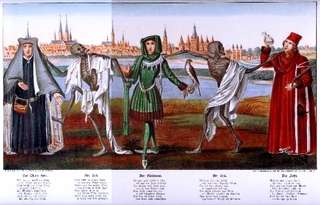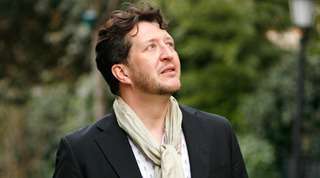|
Back
And Death Shall Have a 45-Minute Dominion New York
Avery Fisher Hall, Lincoln Center
03/12/2015 - & March 13, 14, 2015
Ludwig van Beethoven: Symphony No. 1 in C Major, Opus 21
Hector Berlioz: Les Francs-Juges, Overture, opus 3, H. 23
Thomas Adès: Totentanz (American Premiere)
Christianne Stotijn (Mezzo-Soprano), Mark Stone (Baritone)
New York Philharmonic Orchestra, Thomas Adès (Conductor)

Totentanz, Mariankirche, Lübeck (© Wikipedia.commons)
”When the bell thunders loudly from the powerful One, then the skeleton falls to ashes
Johann Wolfgang von Goethe, Totentanz
Thomas Adès exhorted his bell–and his drums and cymbals and trumpets and steel sheets and trombones and the largest orchestra he had ever assembled–to thunder so loudly in his own Totentanz that a dozen people walked out of Avery Fisher Hall last night. But to hell with them–literally. Or perhaps to heaven with them–literally. For Mr. Adès has created the kind of mordant, ferocious grotesque picture of death, that it almost rivals the (now demolished) frieze on the Lubeck church shown above.
Had Gustav Mahler been composing in 2013, his song cycle could well have been Mr. Adès continuous song cycle here. (Or it could have been composed by Witold Lutoslawski and his wife, to whom it was dedicated.) Orchestrally, the Englishman can rival the Central European. And the words, structured with a searing exactitude, tackles the same problem as Mahler: the end of life, the death of children and the contrast of earthly life with eternal death. Except that with Mahler there was hope. Mr. Adès signifies nothing except hopelessness.

T. Adès (© NY Philharmonic)
No matter what the sonorities, the clashing sounds, the dances and horrors, Mr. Adès has fashioned a transparent scenario, based on the traditional dance of death. Baritone Mark Stone plays Death himself, a stentorian sneering harbinger who spares nobody. Mezzo-soprano Christianne Stotijn sings each of these “nobodies”. In turn, Pope, Emperor, King, Knight, Doctor, Usurer, Merchant, Handworker, Ambitious Clerk, Peasant, Maiden and Baby. They may plead or confess, they either surrender or they may be too young to understand. But no matter what they say or do, Death is intransigent, inexorable. Death is the great finality. In the words of Dylan Thomas, “After the first death, there is no other.”
As in Mahler, the orchestra is a voice of its own. Mr. Adès has assembled an ensemble that takes up an entire column in the program, half of it percussion. And if we couldn’t totally make out the sounds of the “two Swanee whistles”, the “referee’s whistle” (Soccer bleu!), two siren whistles, xylophone, marimba, vibraphone, and drums galore, the full impact of the sounds are shown from the beginning.
In his orchestral use, Mr. Adès was as subtle as Death. That is, not subtle at all. He begins with the wrong clash of orchestral color, since this is a clash which would actually wake the dead, the drums leading the percussion in announcing his message of doom.
Mr. Stone starts with the announcement that “you must dance to my pipe”, and yes, Mr. Adès lets his piccolos and flutes tootle and blur the lines, as the Pope finds that he too will die. Breathlessly, Death announces his message. But lyrically, the victims answer the call. “Lyrically” is not quite the right word, for Ms. Stotijn begins atonally, though these are the atonal lines of an Alban Berg. At times she sings duets with Death, and only by the ending, the deaths of Peasant and Maiden and Baby, does her voice calm down to something approaching a melody…and a lullaby. Just as the orchestra, still dense with color, becomes more harmonic, trumpets singing in thirds.
Mr. Adès never allowed the relentless orchestra to allow us the luxury of criticism. For he was almost audacious in his literal pictures. The monk waltzes, the knight faces death with military tattoos, the child passes on with a simple lullaby. But perhaps this is apt. When the Grim Reaper approaches, we want to hug what is most familiar to us.
In the final moments, Death tells us to “Dance...dance...dance” But this is not exactly the stuff of Fred Astaire. The orchestra is abbreviated down to bassoon, contrabassoon, contrabassoon going down to a low A, and possibly the lowest notes on the piano for the doleful ending.
To repeat, this is not a work of nuance. It is blatant, fierce, cannot possibly be misinterpreted. The closest it comes to shadings are the Shades of Death. In between, Mr. Adès works in bars of the Dies Irae, those macabre monkish waltzes (an homage to Liszt’s Totentanz?) and full-blown ear-trembling demonic dissonances.
In one way, Mr. Adès has triumphed with this most significant work. In another way, he may have failed. Since, unlike other contemporary music, I believe that Totentanz may have an afterlife. Orchestras with the right players and singers with the right chops could–should–give Totentanz as much fame as Mahler’s song-cycles. If an audience wants elegance or niceness or music to soothe the savage breast, they can stay away. Mr. Adès’s Death is the personification of Doom. And an incredible achievement.
Thomas Adès, well known as a conductor, made his debut with the NY Phil, and his start with an innocent Beethoven First Symphony was a beguiling affair. More important was that the Berlioz Francs-Juges overture was a fitting prelude to the Totentanz. True, Berlioz wrote his own dances of death in the last movements of the Fantastic Symphony, but this early musical piece of a Medieval German tribunal was a precursor to the sentence of death itself with the same trombones and horns that he signified the sentence of doom since the instruments were invented.
Mr. Adès offered more than a sentence of death, it was the horror of death. And if anyone in the audience thought he shouldn’t be so literal, one must remember that philosophy is a luxury of the living. The composer approached as the Medieval mind approached the Black Plague and a literal hell. With morbidity and madness and the reality of that chilling 15th Century frieze.
Harry Rolnick
|